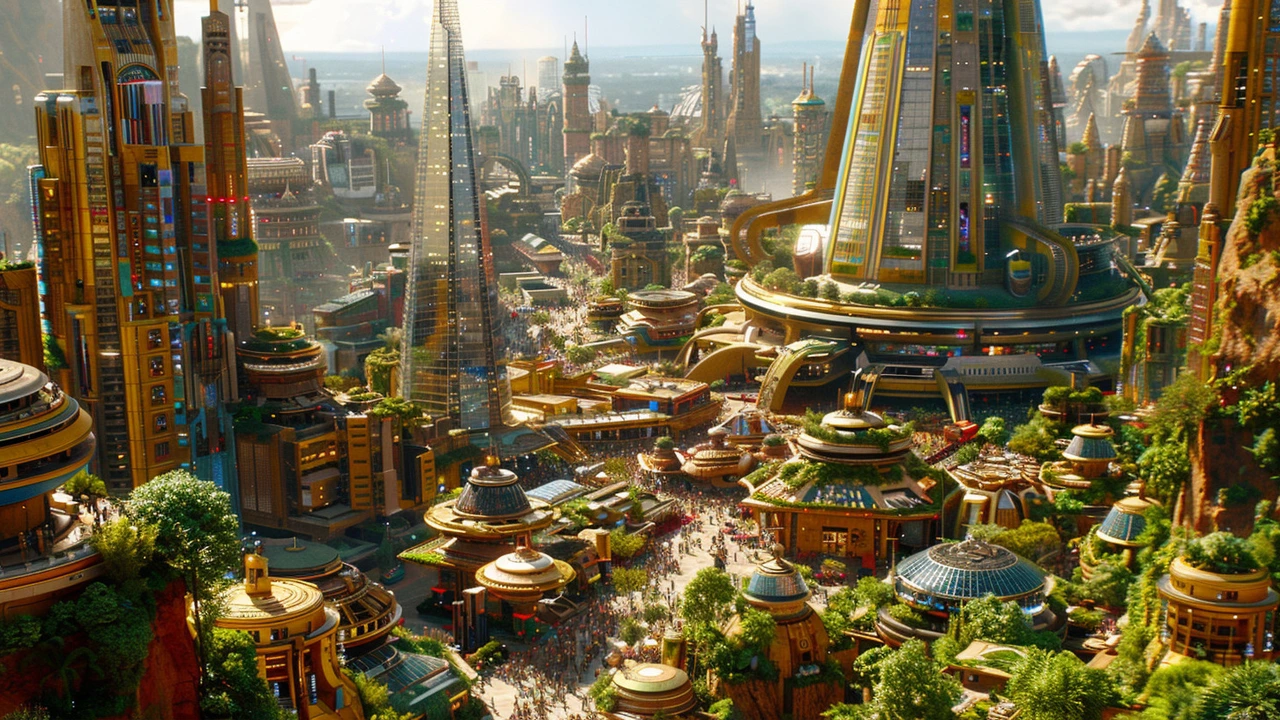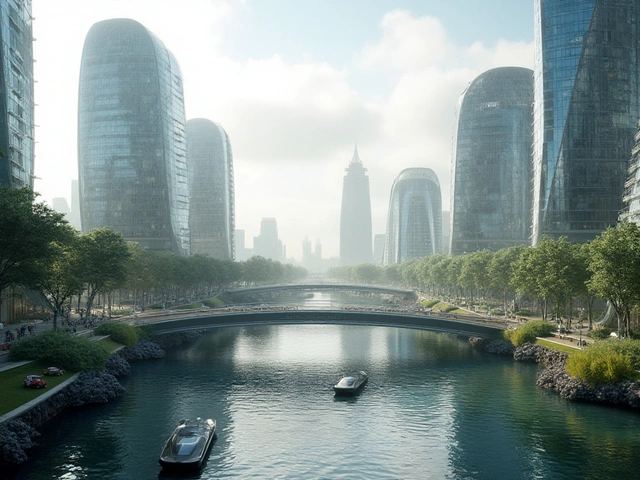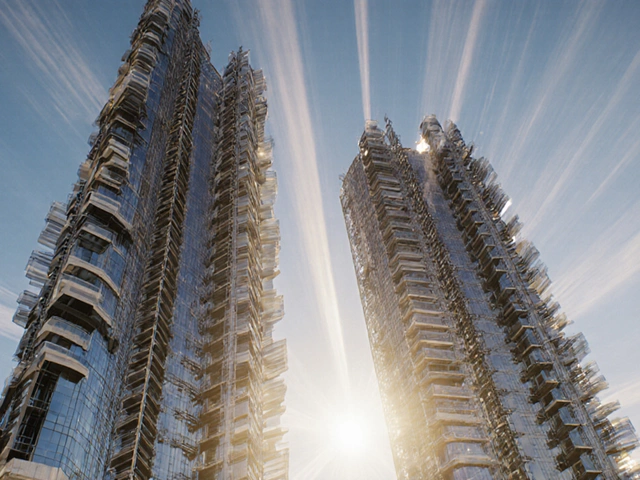Today's architectural landscape is bursting with innovation. High-tech architecture integrates advanced technologies into modern building designs, resulting in highly functional and aesthetically pleasing structures. It's not just about aesthetics; these buildings often aim for sustainability, efficiency, and user comfort.
High-tech architecture uses smart materials that adapt to environmental changes, like self-cleaning glass or kinetic facades that move with the sunlight. This field also embodies green building practices, reducing carbon footprints and promoting energy efficiency.
From London's Gherkin with its unique ventilation system to Singapore's Marina Bay Sands, the world boasts numerous examples of high-tech architecture. These structures exemplify how design and technology can converge to create iconic landmarks.
The future of high-tech architecture looks promising with trends pointing towards even more automation, personalized building environments, and advanced sustainability features. For those interested in diving deep into this field, keeping up with current trends and continuously learning about new materials and technologies is vital.
- Understanding High-Tech Architecture
- The Role of Smart Materials
- Sustainability in High-Tech Buildings
- Iconic High-Tech Structures Around the World
- Future Trends and Predictions
- Practical Tips and Insights
Understanding High-Tech Architecture
High-tech architecture is a style that emerged in the late 20th century, focusing on incorporating advanced technologies and industrial materials into building design. Its essence can be found in the use of visible structural elements, glass surfaces, and modern materials that not only serve a functional purpose but also become key aesthetic components. Characterized by an emphasis on transparency, flexibility, and innovation, it aims to reflect the technological advancements of the era.
The roots of high-tech architecture can be traced back to architects like Norman Foster, Richard Rogers, and Renzo Piano, who sought to blur the lines between architecture and engineering. Their designs often feature exposed steel frameworks, extensive use of glass, and elements like air ducts, elevators, and staircases that are not hidden away. The Centre Pompidou in Paris is a classic example, where the building’s services are visible on its exterior.
One of the hallmarks of high-tech architecture is its adaptability. Buildings like the Lloyd’s building in London are designed to allow for modifications and technological upgrades over time. This means they not only meet current needs but can also be retrofitted for future uses. In many instances, these structures are constructed with modular components that can be assembled and reassembled as needed.
Environmental sustainability is another critical aspect of high-tech architecture. With an increasing awareness of environmental issues, many high-tech buildings incorporate features such as solar panels, rainwater harvesting systems, and energy-efficient lighting. These are not just add-ons but integral parts of their design. For instance, the Bank of America Tower in New York is lauded for its green design, which includes an urban garden and a rainwater harvesting system.
Moreover, the use of smart materials significantly influences high-tech architecture. These materials can adapt to environmental changes, enhance building efficiency, and improve user comfort. For example, electrochromic glass can change its tint in response to sunlight, reducing the need for artificial lighting and cooling. Likewise, self-healing concrete can repair its own cracks, extending the lifespan of structures and reducing maintenance costs.
The goal of high-tech architecture is often to create spaces that are not just buildings but dynamic environments that respond to their occupants and surroundings. Interactive facades, climate control systems that adjust based on occupancy, and integrated technology for seamless communication are typical features. This approach makes these buildings highly functional while maintaining a sleek, modern aesthetic.
In a quote from Norman Foster, he aptly describes this architectural style:
“As an architect, you design for the present with an awareness of the past for a future which is essentially unknown.”This philosophy underscores a forward-thinking approach while honoring the technological and material heritage.
The field of high-tech architecture continues to evolve as new technologies emerge and sustainability becomes ever more critical. Architects and designers are constantly pushing the boundaries to create buildings that are not only technologically advanced but also environmentally responsible. Understanding this architecture means appreciating a harmonious blend of function, technology, and aesthetics that looks to the future.
The Role of Smart Materials
Smart materials are revolutionizing the field of high-tech architecture. These materials possess unique properties that can change or adapt in response to environmental stimuli. They bring a whole new dimension to architectural design, merging functionality with innovation. Imagine a building facade that can respond to changes in temperature, light, or humidity. This level of adaptability can significantly improve energy efficiency and occupant comfort.
One prominent example of smart materials is self-cleaning glass, which uses a special coating to break down dirt and grime when exposed to sunlight. This reduces the need for manual cleaning, cutting down on maintenance costs and effort. Kinetic facades, which can move and adapt based on solar patterns, are another fascinating use of smart materials. These dynamic surfaces can help regulate a building's internal temperature by controlling the amount of sunlight that enters.
Thermochromic materials, which change color with temperature fluctuations, are also making waves in architecture. Such materials can be used in windows or walls to automatically adjust the building's opacity, thereby controlling heat gain and enhancing energy efficiency.
"Smart materials are not just a futuristic concept; they are here and ready to transform the way we build," says Dr. Maria Gomez, an expert in sustainable urban design.
Piezoelectric materials are another exciting innovation. These materials generate electrical energy when subjected to mechanical stress. Imagine floors that can harness the energy of people's footsteps to power lights or small devices. This blend of sustainability and practicality shows how smart materials can provide innovative solutions for urban challenges.
The use of phase-change materials (PCMs) in buildings is another example of smart technology at work. PCMs can absorb, store, and release large amounts of energy during phase transitions, such as when they change from solid to liquid. This property can be used to regulate indoor temperatures, reducing the need for artificial heating and cooling.
Integration and Future Prospects
Integrating smart materials into building designs requires interdisciplinary collaboration. Architects, engineers, and materials scientists need to work together to ensure these materials are implemented effectively. The potential benefits are enormous. Not only can they enhance building performance and reduce environmental impact, but they can also create more comfortable and adaptive living spaces.Looking ahead, the development of new smart materials continues to advance. Research is ongoing to create materials with even more sophisticated properties. We might soon see buildings with facades that can repair themselves, materials that harvest energy from the environment, or surfaces that can change texture based on their surroundings. The possibilities are endless and incredibly exciting for the future of high-tech architecture.
Sustainability in High-Tech Buildings
When we discuss sustainability in high-tech buildings, we're exploring how advanced technologies contribute to creating environmentally friendly and energy-efficient structures. Architects and engineers are constantly seeking ways to minimize the environmental impact of buildings, and high-tech architecture offers innovative solutions to achieve these goals. One of the key elements in this field is the use of smart materials and systems that respond to environmental conditions, ensuring optimal performance and reduced energy consumption.
For example, buildings with adaptive facades can regulate heat, light, and airflow, significantly reducing the need for artificial heating and cooling. The
Iconic High-Tech Structures Around the World
High-tech architecture has gifted the world with some of its most impactful and breathtaking buildings. These structures do not just dominate skylines, but they also represent the evolution of architectural design, integrating cutting-edge technology and innovative materials. One such iconic building is The Gherkin in London. Officially known as 30 St Mary Axe, this building has redefined the London skyline with its distinctive shape and advanced energy-saving features. The tower uses a unique natural ventilation system that helps it use 50% less energy than a typical office building.
Another marvel is the Marina Bay Sands in Singapore. This integrated resort is famous for its three-tower structure topped by a sky park. The engineering behind the SkyPark, which appears to float atop the towers, is truly impressive. This park has the world's longest elevated swimming pool, offering an unparalleled view of the Singapore skyline. Its construction utilized advanced building techniques and materials, showcasing the perfect blend of technology and creativity.
Moving to the Middle East, the Burj Khalifa stands as the tallest building in the world. Located in Dubai, this skyscraper reaches a height of 828 meters. Its design incorporates a tiered structure, enabling the reduction of the wind forces and providing structural support as it ascends. Additionally, the exterior cladding of the Burj Khalifa stands out for reflecting efficient heat and sunlight, further enhancing its sustainability.
Europe is home to Centre Pompidou in Paris, a building renowned for its exposed skeleton of brightly colored tubes for mechanical systems. This bold design choice results in an inside-out building that maximizes indoor space. The central concept behind Centre Pompidou challenges traditional architecture by turning the building itself into a work of art. It is a symbol of innovation, melding function with futuristic aesthetics.
"High-tech architecture represents the fusion of technological innovation and structural artistry," says renowned architect Lord Norman Foster. "It is about pushing the boundaries while retaining an elegant simplicity."
In Asia, Tokyo's Mode Gakuen Cocoon Tower is a stunning example of high-tech design in educational buildings. The tower's cocoon shape embodies Japan's commitment to futuristic architecture, providing earthquake resistance and energy efficiency. Each floor is designed to optimize learning and collaboration, highlighting how form and function can harmoniously blend.
Sydney Opera House is another structure that exemplifies the heights of high-tech architecture. Its design is characterized by its sail-like shells, an engineering feat made possible through computer modeling and innovative construction techniques. Opened in 1973, it remains a masterpiece of modern architecture, symbolizing artistic and engineering excellence.
These buildings are more than just physical structures; they are milestones that represent the advancements and aspirations of societies. Exploring the world of high-tech architecture is like embarking on a global journey through the combined realms of engineering innovation and creative design.
Future Trends and Predictions
As technology continues to evolve at breakneck speed, so too does the field of high-tech architecture. The future holds exciting possibilities, promising even more intelligent and sustainable buildings. One key trend is the increasing integration of *artificial intelligence* and *machine learning* in architectural design. These technologies enable more precise and efficient designs, optimizing energy use and enhancing the human experience within spaces.
Imagine a building that adapts to your needs in real-time. Smart homes are already becoming a reality, with systems that control lighting, heating, and security. Future high-tech buildings will likely take this a step further, incorporating advanced sensors and AI to monitor and adjust conditions based on occupants' preferences and activities. This shift will make buildings more interactive and responsive, creating a seamless blend of architecture and technology.
Sustainability continues to be a driving force in high-tech architecture. The future will see even greater emphasis on *sustainable materials* and *energy-efficient designs*. Innovations such as vertical gardens and green roofs are going to become more common, transforming urban areas into greener, more breathable spaces. Innovative materials that can capture and store energy or even purify air will play a significant role in reducing the environmental impact of buildings.
Modular construction is another trend shaping the future of high-tech architecture. The ability to create prefabricated modules off-site and assemble them quickly on-site not only reduces construction time and costs but also minimizes waste and disruption. This method aligns perfectly with the industry's increasing focus on sustainability and efficiency.
Thomas Heatherwick, a renowned architect, once said, "The key battle to work out is how to do something that lasts twenty or thirty years instead of ten years."
Automation is also set to revolutionize the construction industry. Drones and robots are already being used for surveying and building, and their role will likely expand. 3D printing has the potential to create entire structures more quickly and with less material waste than traditional methods, making it an exciting development in high-tech construction.
The aesthetic aspect of high-tech architecture should not be overlooked. Future designs will prioritize transparency and openness, with extensive use of glass and open spaces. These elements not only create visually stunning buildings but also contribute to a sense of well-being among occupants. As urban populations grow, designing buildings that promote mental and physical health will become increasingly important.
Lastly, personalized environments are becoming a reality. High-tech architecture aims to accommodate individual needs and preferences. From adaptive lighting to customizable room layouts, future buildings will offer unparalleled flexibility and comfort. This focus on personalization is expected to enhance productivity and overall satisfaction for occupants.
The future of high-tech architecture is bright and full of potential. By embracing new technologies, prioritizing sustainability, and focusing on the human experience, future buildings will not only be marvels of design and engineering but also more comfortable, efficient, and environmentally friendly places to live and work.
Practical Tips and Insights
High-tech architecture can be both inspiring and overwhelming. Yet, for those looking to integrate these innovative concepts into their own projects, there are some practical tips and insights that can help simplify the process. One of the fundamental aspects is understanding the role of smart materials. Materials like electrochromic glass, which can change transparency with electrical input, and responsive facades that adjust to climatic conditions, are essential. Incorporating these materials doesn't just improve aesthetics but also enhances functionality.
Another critical tip is focusing on sustainability. It's not just a buzzword; sustainable practices are the backbone of high-tech architecture. Install solar panels, use rainwater harvesting systems, and opt for green roofs. These elements not only reduce the environmental impact but also cut long-term operational costs. According to a study by the World Green Building Council, sustainable buildings can reduce energy consumption by up to 30%.
"Sustainable architecture is more than just an environmental necessity; it’s an opportunity to create healthier and more efficient spaces," says Jeremy Rifkin, a leading architect in sustainable design.
Embracing automation is another vital step. Smart buildings often feature automated systems for lighting, heating, and security. These systems can be controlled via smartphones or centralized building management systems, offering convenience and efficiency. The integration of IoT (Internet of Things) enables these systems to learn and adapt to the occupants' preferences over time.
To ensure smooth implementation, it's crucial to work with a team of experts. Engage with architects, engineers, and sustainability consultants who specialize in high-tech architecture. Their expertise can help navigate the challenges and intricacies involved in modern building projects. An integrated approach ensures that all elements, from design to construction and maintenance, work harmoniously.
Cost is always a consideration. While high-tech architectural elements can be pricey, they often provide long-term savings. Investing in energy-efficient systems, for instance, might have a higher upfront cost but can significantly reduce utility bills over time. According to data from the U.S. Department of Energy, green buildings can save up to 50% in water usage and 40% in energy costs.
| Benefit | Regular Buildings | High-Tech Buildings |
|---|---|---|
| Energy Consumption | High | Low |
| Water Usage | High | Low |
| Maintenance | Frequent | Infrequent |
High-tech architecture is as much about the future as it is about the present. Keeping an eye on emerging trends, such as the use of AI in building management and new sustainable materials, can provide a competitive edge. Attending architectural expos, subscribing to industry journals, and participating in online forums can help stay informed and inspired.
Finally, don't underestimate the aesthetic component. High-tech architecture blends form with function. Allow creativity to lead, but ensure that it aligns with practical needs. Iconic high-tech structures like the Louvre Pyramid in Paris or the Sydney Opera House are not just architectural feats but cultural landmarks.
In the journey of integrating high-tech architecture, balance is key. Weigh the benefits against costs, aesthetics against functionality, and innovation against tradition. Taking a thoughtful, informed approach can help create spaces that are not only beautiful but also smart, sustainable, and future-ready.





